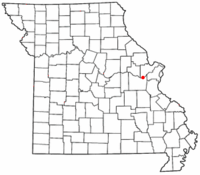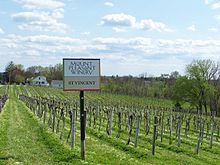| Wine region | |
 View of the Augusta AVA from Montelle Winery located on the hill top region around the city of Augusta. | |
| Type | American Viticultural Area |
|---|---|
| Year established | 1980 [1] |
| Country | United States |
| Part of | Missouri, Ozark Mountain AVA |
| Climate region | humid continental/humid subtropical |
| Total area | 15 square miles (39 km2) [2] |
| Grapes produced | Cabernet Sauvignon, Chambourcin, Chardonel, Chardonnay, Couderc noir, Norton, Rayon d'Or, Seyval blanc, St. Vincent, Vidal blanc, Vignoles [3] |
| No. of wineries | 4 [3] |
The Augusta AVA was established on June 20, 1980 as the first federally approved American Viticultural Area, eight months before the Napa Valley AVA in northern California. The petition was submitted by Clayton W. Byers and Lucian W. Dressel, representing the local wine industry, to the Director of the Bureau of Alcohol, Tobacco and Firearms on October 16, 1978. [4] Located entirely within the state of Missouri, the boundaries of this wine region encompass 15 square miles (39 km2) around the city of Augusta near the intersection of St. Charles County, Warren County and Franklin County. [2]
History
The area around the present day city of Augusta was founded in 1836 by Leonard Harold, a follower of Daniel Boone, as a riverboat landing along the Missouri. The town was originally named Mount Pleasant with the riverboat landing known as Augusta Bend. In 1855, the town was incorporated as the city of Augusta. In 1859, Georg and Friedrich Muench founded one of the earliest wineries in the area, Mount Pleasant Winery. [5] Flooding in the Missouri River valley caused the river to change course in 1872, drying up the area's riverboat landing and leaving a distinct soil type in the area between the town and the river. The area's early vineyards were planted in the 1880s and the area began receiving recognition for the distinctive flavors and profile of the wine being produced there. In the later parts of the 19th and early 20th century, the production volume from the area helped the Missouri wine industry compete with Ohio for market share east of the Rocky Mountains. [6] The advent of Prohibition had a dramatic effect on the area causing the closure of local wineries and the uprooting of vineyards. A revival period occurred in the 1960s that led to the founding of many of the area's current wineries. [7]
At the turn of the 21st century, wines from the Augusta AVA were exported to Germany. In 2003, Augusta Winery's 2001 Chardonel won "Best US wine" from the German wine magazine Selection at their yearly competition in Mainz. [7]
Geography and soil

Located 40 miles (64 km) west of St. Louis along the Missouri River, the area is known for its river bottoms and alluvial plains that follow the winding river. The soil in this area is a type of loam known as Hayne Silt-Loam which is heaviest in clay composition in the areas closest to the river but has more silt concentration in the higher elevations where most of the vineyards are now located. [2]
Grapes

The Augusta AVA is planted with some Vitis vinifera including Cabernet Sauvignon, Pinot noir, Chardonnay, and Merlot as well the Vitis aestivalis grape Norton which is the official grape of the State of Missouri. [8] French-American hybrid grapes like Chambourcin, Chardonel, Couderc noir, Rayon d'Or, Seyval blanc, St. Vincent and Vidal blanc are also popular plantings.
References
- ^ "§9.22 Augusta" (Title 27: Alcohol, Tobacco and Firearms; Part 9 — American Viticultural Areas; Subpart C — Approved American Viticultural Areas). Code of Federal Regulations (e-CFR). Retrieved February 5, 2008.
- ^ a b c Pingelton, Tim (December 8, 2005). "The Soul of Augusta". Appellation American. Archived from the original on July 24, 2008.
- ^ a b "Augusta (AVA): Appellation Profile". Appellation America. 2007. Archived from the original on March 3, 2016.
- ^ "Augusta AVA Petition" (PDF). Alcohol and Tobacco Tax and Trade Bureau. Code of Federal Regulations.
- ^ Durfur, Brett (2007). Exploring Missouri Wine Country (3rd ed.). Pebble Publishing. p. 43. ISBN 978-1-891708-30-5.
- ^ Johnson, Hugh; Robinson, Jancis (October 8, 2013). The World Atlas of Wine (7th ed.). Mitchell Beazley Publishing (first published 1971). p. 269. ISBN 978-1845333010.
- ^ a b Durfur (2007), pp.35,37.
- ^ Garfunkel, Arthur (June 1, 2004). "Norton: Missouri's State Grape Harbors Juicy Little Secrets". Sauce Magazine. Archived from the original on July 15, 2007.